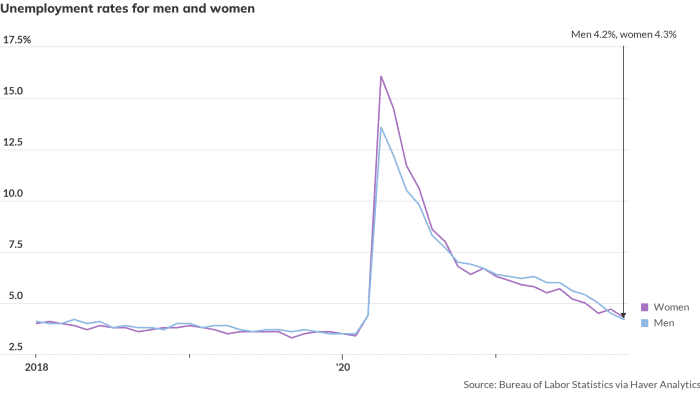This post was originally published on this site
WASHINGTON (MarketWatch) — The pandemic recession hit some groups much harder than others, but those differences are slowly fading away. As of November, the unemployment rate for Black people, and for women, had fallen back to more “normal” levels and the gap had narrowed compared with more privileged groups.
In November, the jobless rate for Black Americans dropped by 1.2 percentage points to 6.7%, which is the lowest since February 2020, when it was 6.0%. That compares with an unemployment rate of 3.7% for workers who identify themselves as white. That’s about where their respective jobless rates were in late 2018.
Breaking news: November’s 210,000 new jobs marks worst headline number of 2021 — but there are bright spots
Historically, the unemployment rate for Black people has been about twice that of white people, but that changed during the later stages of the recovery from the Great Recession of 2008, as the economy crept closer to full employment and more Black job seekers found employment. The latest figures show that some of the gains made by Black people in the labor market in those days have persisted even through the pandemic.
However, the unemployment rate is a crude measurement of the job market’s health, because it depends crucially on labor-force participation: You can’t be counted as unemployed if you aren’t looking — and lots of people aren’t looking.
The labor-force participation rate dropped precipitously for all groups during the recession last year, but it fell more for some groups than others. The Black labor-force participation rate, for example, fell 4.5 percentage points in the first two months of the pandemic, while the participation rate for white people fell only half as much, 2.2 points.
By August of this year, the Black participation rate had caught up with the rate for white Americans, but it has fallen behind again in recent months. Around 91,000 Black women exited the labor force in November.
Economists say that people have left the labor force for many reasons, including the fact that a large number of workers have retired. Others stayed out of the labor force because their children couldn’t go to school or daycare, because they were caring for others, or because they were afraid of becoming infected on the job. Still others figured that working didn’t pay because they were getting federal unemployment or stimulus benefits.
For the population as a whole, the participation rate remains 1.5 percentage points below the pre-pandemic level, which means that the labor force is about 3.8 million lower than it would be if participation rates had recovered fully.

The unemployment gap between men and women has disappeared.
MarketWatch
Women have also regained much of the ground they lost during the pandemic, at least as far as the unemployment rate goes. Early in the pandemic, the jobless rate for women got as high as 16.1%, while the rate for men topped out at 13.6%. But now their unemployment rates are nearly identical: 4.2% for men and 4.3% for women. That’s where their jobless rates were in early 2018.
But here, too, the unemployment rate is an imperfect indicator given that mothers with school-age children are experiencing a child-care crisis. If the labor-force participation rate for women had returned to pandemic levels, there would be about 2.1 million more women in the labor force.
Rex Nutting has been covering economics for more than 25 years.

